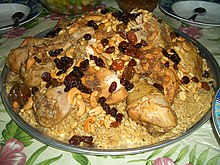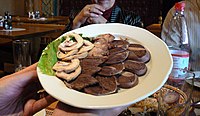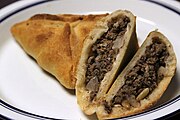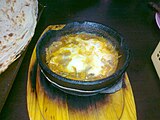List of Asian cuisines: Difference between revisions
→References: + {{cuisine}} {{Asian topic|| cuisine}} |
→Southeast Asian cuisine: Copy attribution: merged content to this article from Global cuisine. wf. |
||
| Line 133: | Line 133: | ||
File:NasiLemak.JPG|[[Nasi Lemak]] is commonly found in [[Malaysia]] and [[Singapore]]. |
File:NasiLemak.JPG|[[Nasi Lemak]] is commonly found in [[Malaysia]] and [[Singapore]]. |
||
File:Halo halo1.jpg|''[[Halo-halo]]'' is a [[Philippine cuisine|Filipino]] dessert. |
File:Halo halo1.jpg|''[[Halo-halo]]'' is a [[Philippine cuisine|Filipino]] dessert. |
||
Image:Thai market food 01.jpg|A market stall at Thanin market in [[Chiang Mai]], [[Thailand]] selling ready cooked food |
|||
</gallery> |
</gallery> |
||
</center> |
</center> |
||
Revision as of 20:01, 26 May 2013

This is a list of Asian cuisines. A cuisine is a characteristic style of cooking practices and traditions,[1] often associated with a specific culture. Asia, being the largest and most populous continent, has numerous cuisines. Ingredients common to many cultures in the east and Southeast regions of the continent include rice, ginger, garlic, sesame seeds, chilies, dried onions, soy, and tofu. Stir frying, steaming, and deep frying are common cooking methods. While rice is common to most Asian cuisines, different varieties are popular in the various regions; Basmati rice is popular in the subcontinent, Jasmine is often found across the southeast, while long-grain rice is popular in China and short-grain in Japan and Korea.[2] Curry is also a common dish in found in southern and eastern Asia, however they are not as popular in eastern cuisines. Those curry dishes with origins in India and other South Asian countries usually have a yogurt base while Southeastern and Eastern curries generally use coconut milk as their foundation.[3]
Central Asian cuisine

- Afghan cuisine is largely based upon the nation's chief crops: cereals like wheat, maize, barley and rice. Accompanying these staples are dairy products (yogurt and whey), various nuts, and native vegetables, as well as fresh and dried fruits. Afghanistan is well known for its grapes.
- Kazakh cuisine is the cuisine of Kazakhstan. Traditional Kazakh cuisine revolves around mutton and horse meat, as well as various milk products. For hundreds of years Kazakhs were herders who raised fat-tailed sheep, Bactrian camels, and horses, relying on these animals for transportation, clothing, and food.[4]
- Kyrgyz cuisine - originating in Kyrgyzstan, is similar in many respects to that of its neighbors, particularly Kazakh cuisine. Traditional Kyrgyz food includes mutton and horse meat, and milk products. The cooking techniques and major ingredients have been strongly influenced by the nation's nomadic way of life.
- Mongolian cuisine refers to the local culinary traditions of Mongolia and Mongolian styled dishes. The extreme continental climate has affected the traditional diet, so the Mongolian cuisine primarily consists of dairy products, meat, and animal fats. Use of vegetables and spices is limited.
- Tajik cuisine, the traditional cuisine of Tajikistan, has much in common with Afghan, Iranian, Russian, and Uzbek cuisines. Plov (pilaf), also called osh, is the national dish in Tajikistan, as in other countries in the region. It consists of chunks of mutton, carrots and rice fried in a large cast-iron cauldron similar to a Dutch oven. Green tea is the national drink. Traditional Tajik meals start with a spread of dried fruit, nuts, halwa, and other sweets arrayed on the table in small dishes, and then progress to soup and meat, before finishing with plov.
- Tibetan cuisine
- Turkmen cuisine, the cuisine of Turkmenistan, is similar to that of the rest of Central Asia. Plov is the staple, everyday food, which is also served at celebrations. Turkmenistan is perhaps most famous for its melons, especially in the former Soviet Union, where it was once the major supplier. Meals are almost always served with naan, Central Asian flat bread, known locally as "çörek."
- Uyghur cuisine (Cuisine of Xinjiang)
- Uzbek cuisine is influenced by local agriculture, as in most nations. There is a great deal of grain farming in Uzbekistan, so breads and noodles are of importance, and Uzbek cuisine has been characterized as "noodle-rich".[5] Mutton is a popular variety of meat due to the abundance of sheep in the country and it is a part of various Uzbek dishes.
-
Khorkhog (left) is a type of stew consumed in Mongolian cuisine.
East Asian cuisine



East Asian cuisine – evolved with a common usage of oils, fats and sauces in the preparation of dishes (with the notable exception of Japanese cuisine).
- Chinese cuisine – originated in what is known as the Eight Great Traditions, though it can be generalized into northern styles that feature oils and strong flavors derived from ingredients such as vinegar and garlic while southern styles tend to favor fresh ingredients that are lightly prepared. It has become widespread throughout many other parts of the world — from Asia to the Americas, Australia, Western Europe and Southern Africa. In recent years, connoisseurs of Chinese cuisine have also sprouted in Eastern Europe and South Asia. American Chinese cuisine and Canadian Chinese food are popular examples of local varieties. Local ingredients would be adopted while maintaining the style and preparation technique.
- Wine in China
- Great Traditions
- Eight Great Traditions – Regional cultural differences vary greatly amongst the different regions of China, giving rise to eight main regional cuisines, or Eight Great Traditions (八大菜系, Bā Dà Cài Xì)
- Anhui is derived from the native cooking styles of the Huangshan Mountains region in China and is similar to Jiangsu cuisine. It is is known for the use of wild herbs, from both land and sea, and simple methods of preparation.
- Cantonese comes from Guangdong Province in southern China[6] Due to Guangdong's location on the southern coast of China, fresh live seafood is prominent in Cantonese cuisine. Canton has long been a trading port and many imported foods and ingredients are used in Cantonese cuisine. Char siu is a popular way to flavor and prepare pork in Cantonese cuisine.[7]
- Fujian is one of the native Chinese cuisines derived from the native cooking style of the province of Fujian, China. Many diverse seafoods and woodland delicacies are used, including a myriad of fish, shellfish and turtles, along with edible mushrooms and bamboo shoots, provided by the coastal and mountainous regions of Fujian.[8]
- Hunan, sometimes called Xiang cuisine, consists of the cuisines of the Xiang River region, Dongting Lake and western Hunan Province, in China. The cuisine is well known for its hot spicy flavor, fresh aroma and deep color. Common cooking techniques include stewing, frying, pot-roasting, braising, and smoking. Due to the high agricultural output of the region, ingredients for Hunan dishes are many and varied.
- Jiangsu is derived from the native cooking styles of the Jiangsu region in China. Food texture is often soft, but not to the point of mushy or falling apart. Other characters includes the strict selection of ingredients according to the seasons, emphasis on the matching color and shape of each dish and emphasis on using soup to improve the flavor.
- Shandong in Chinese is more commonly known as Lu cuisine, and is derived from the native cooking styles of Shandong, an eastern coastal province of China. Possibly Shandong's greatest contribution to Chinese cuisine has been in the area of brewing vinegars. Hundreds of years of experience combined with unique local methods have led to Shandong's prominence as one of the premier regions for vinegar production in China.
- Sichuan is a style of Chinese cuisine originating in the Sichuan Province of southwestern China famed for bold flavors, particularly the pungency and spiciness resulting from liberal use of garlic and chili peppers, as well as the unique flavor of the Sichuan peppercorn (花椒). Peanuts, sesame paste, and ginger are also prominent ingredients in Szechuan cooking.[9]
- Zhejiang is derived from the native cooking styles of the Zhejiang region in China. Food made in the Zhejiang style is not greasy, having instead a fresh and soft flavor with a mellow fragrance.[10]
- Four Great Traditions – are often considered as the standouts of Chinese cuisine and due to their influence are proclaimed as the Four Great Traditions (四大菜系, Sì Dà Cài Xì).
- Cantonese
- Sichuan
- Shandong
- Huaiyang cuisine – often viewed as the representation of the entire Jiangsu cuisine.
- Four Great Traditions – are often considered as the standouts of Chinese cuisine and due to their influence are proclaimed as the Four Great Traditions (四大菜系, Sì Dà Cài Xì).
- Chinese cultural subcuisines
- Chinese cuisines, by region
- Eight Great Traditions – Regional cultural differences vary greatly amongst the different regions of China, giving rise to eight main regional cuisines, or Eight Great Traditions (八大菜系, Bā Dà Cài Xì)
- Japanese cuisine is known for its emphasis on seasonality of food (旬, shun),[12] quality of ingredients and presentation. Japanese regional cuisine includes a vast array of regional specialities known as kyōdo ryōri in Japanese, many of them originating from dishes prepared using local ingredients and traditional recipes.[13] Sushi and sashimi are both part of the cuisine of the island nation. The Michelin Guide has awarded Japanese cities by far the most Michelin stars of any country in the world (for example, Tokyo alone has more Michelin stars than Paris, Hong Kong, New York, LA and London combined).[14][15]
- Traditional cooking methods eschew the use of oils and fats, with a focus on featuring the delicate flavors of the natural ingredients. Due to an abundant seafood supply, the traditional Japanese diet featured minimal use of meat; however, modern Japanese cuisine includes an extensive variety of popular meat dishes. Japanese cuisine offers a vast array of regional specialties that use traditional recipes and local ingredients.
- Japanese wine
- Okinawan cuisine is the cuisine of the Japanese island of Okinawa. Due to difference in culture, climate, vegetables and other ingredients between Okinawa and mainland Japan, Okinawan cuisine is very different from Japanese cuisine. The cuisine incorporated influence from Chinese cuisine and Southeast Asian cuisine due to trade. The sweet potato, introduced in Okinawa in 1605, became a staple food in there from then until the beginning of the 20th century. An article about Okinawan food written by Kikkoman stated that Goya (bitter melon) and Nabera (luffa or towel gourd) were "likely" introduced to Okinawa from Southeast Asia. Since Ryukyu had served as a tributary state to China, Ryukyuan cooks traveled to Fujian Province to learn how to cook Chinese food; Chinese influence seeped into Okinawa in that manner. The same Kikkoman article states that the method of distillation of awamori likely originated from Siam (Thailand) and traveled to Okinawa during the 15th century. After the lord of the Kagoshima Domain invaded the Ryukyus Okinawan cooks traveled to Japan to study Japanese cuisine, causing that influence to seep into Okinawan cuisine.[16]
- Ainu cuisine
- Traditional cooking methods eschew the use of oils and fats, with a focus on featuring the delicate flavors of the natural ingredients. Due to an abundant seafood supply, the traditional Japanese diet featured minimal use of meat; however, modern Japanese cuisine includes an extensive variety of popular meat dishes. Japanese cuisine offers a vast array of regional specialties that use traditional recipes and local ingredients.
- Korean cuisine originated from ancient prehistoric traditions in the Korean peninsula, evolving through a complex interaction of environmental, political, and cultural trends.[18] Korean cuisine is largely based upon rice, vegetables, and meats. Traditional Korean meals are noted for the number of side dishes (banchan) that accompany steam-cooked short-grain rice. Kimchi is served often, sometimes at every meal. Commonly used ingredients include sesame oil, doenjang (fermented bean paste), soy sauce, salt, garlic, ginger, pepper flakes and gochujang (fermented red chili paste). Korean regional cuisine (Korean: hyangto eumsik, literally "native local foods"),[19] is characterized by local specialties and distinctive styles within Korean cuisine. The divisions reflected historical boundaries of the provinces where these food and culinary traditions were preserved until modern times. Korean barbecue, or gogi gui, refers to the Korean method of grilling beef, pork, chicken, or other types of meat. Such dishes are often prepared at the diner's table on gas or charcoal grills that are built into the center of the table itself. It features cooking methods such as sautéing and what is known in the West as barbecue. Strong flavors featuring spices derived from chili peppers can also be found in dishes such as kimchi.[20]
- Mongolian cuisine
- Taiwanese cuisine
Southeast Asian cuisine



The styles of Southeast Asian cuisine include a strong emphasis on lightly prepared dishes with a strong aromatic component that features such flavors as citrus and herbs such as mint, cilantro (coriander) and basil. Ingredients in the region contrast with the ones in the Eastern Asian cuisines, substituting fish sauces for soy sauce and the inclusion of ingredients such as galangal, tamarind and lemon grass. Cooking methods include a balance of stir-frying, boiling and steaming.[20]
- Cambodian cuisine
- Indonesian cuisine
- Laotian cuisine
- Malaysian cuisine
- Burmese cuisine has been influenced greatly by China, India and Thailand. However, Burmese cuisine has retained unique preparation techniques and distinct flavors, and there are many regional variations of "standard" dishes. The Burmese eat with their right hand, forming rice into a small ball with only the fingertips and mixing this with various morsels before popping it into their mouths. The Burmese eat a great variety of vegetables and fruits, and all kinds of meat. A very popular vegetable is the danyin thi, which is usually boiled or roasted and dipped in salt, oil and sometimes, cooked coconut fat.
- Filipino cuisine
- Singaporean cuisine
- Thai cuisine
- Vietnamese cuisine
- Additional southeast Asian foods and dishes
-
A market stall at Thanin market in Chiang Mai, Thailand selling ready cooked food
South Asian Cuisine



- South Asian cuisine, also known as Desi cuisine, includes the cuisines from the Indian subcontinent. It has roots in South Asia, including practices taken from the Hindu beliefs practiced by the large population found in the region, alongside influences from neighboring regions and cultures, particularly from Muslim cultures of the Middle East and Central Asia, such as Persia, the Turkic and Arabic countries. Dishes in this area of the world are known for their use of hot peppers, black pepper, cloves, and other strong spices along with the flavored butter ghee. Common meats include lamb, goat and chicken; beef is not very common as in western cuisines because the tenets of the Hindu faith prohibit its consumption. Other staples of many of the cuisines include rice, chapati made from wheat and barley, and beans.[20] The cuisine of South Asia has roots in Persia, Turkey, and the Middle East as well as practices taken from the Hindu beliefs practiced by the large population found in the region. Naan, a type of flat bread from the former regions is a common part of meals in many parts of South Asia.
- Bangladeshi cuisine
- Bhutanese cuisine employs a lot of red rice (like brown rice in texture, but with a nutty taste, the only variety of rice that grows at high altitudes), buckwheat, and increasingly maize. The diet in the hills also includes chicken, yak meat, dried beef, pork, pork fat and mutton. When offered food, one says meshu meshu, covering one's mouth with the hands in refusal according to Bhutanese manners, and then gives in on the second or third offer.
- Maldivian cuisine
- Nepalese cuisine
- Pakistani cuisine
- Sri Lankan cuisine
- Indian cuisine is characterized by its sophisticated and subtle use of many spices and vegetables grown across India and also for the widespread practice of vegetarianism across its society. Considered by some to be one of the world's most diverse cuisines, each family of this cuisine is characterized by a wide assortment of dishes and cooking techniques. As a consequence, Indian cuisine varies from region to region, reflecting the varied demographics of the ethnically diverse Indian subcontinent.[21] India's religious beliefs and culture has played an influential role in the evolution of its cuisine. However, cuisine across India also evolved with the subcontinent's cross-cultural interactions with the neighboring Middle East and Central Asia as well as the Mediterranean, making it a unique blend of various cuisines across Asia.[22][23] The colonial period introduced European cooking styles to India adding to its flexibility and diversity.[24][25] Indian cuisine has also influenced cuisines across the world, especially those from Southeast Asia.[26][27][28] In particular, curry has been widely adopted in cuisines around the world.
-
- Bengali cuisine is a style of food preparation originating in Bengal, a region in the eastern South Asia which is now divided between the Indian states of West Bengal, Tripura, and Barak Valley of Assam and the independent country of Bangladesh. Bengali food has inherited a large number of influences, both foreign and South Asian, arising from a historical and strong trade links with many parts of the world.
- Cuisine of Jharkhand
- Oriya cuisine
- Other Indian cuisines
West Asian cuisine (Middle East)



- Middle Eastern cuisine, or West Asian cuisine is the cuisine of the various countries and peoples of the Middle East (Western Asia). Despite their similarities, there are considerable differences in climate and culture, so the term is not definitive. The cuisine of the region is diverse while having a degree of homogeneity.[29] Many Middle Eastern dishes are made with a paste called tahini. Tahini is a sesame paste made with hulled seeds, unlike its Asian counterpart. It is used to make such popular meze, or appetizers, as baba ghanoush and hummus along with pungent dipping sauces served with falafel, keftes or kofta and vegetables.[30] Hummus is made from chickpeas, which are staples of the diet. Some commonly used ingredients include olives and olive oil, lamb,[29] pitas, honey, sesame seeds, dates,[29] sumac, chickpeas, mint and parsley. Some popular dishes include kibbeh[31] and shawarma.[32]
- Arab cuisine – various regional cuisines spanning the Arab World from Iraq to Morocco to Somalia to Yemen, and incorporating Levantine, Egyptian and others. It has also been influenced to a degree by the cuisines of Turkey, Pakistan, Iran, India, the Berbers and other cultures of the peoples of the region before the cultural Arabization brought by genealogical Arabians during the Arabian Muslim conquests.
- Arab cuisine of the Persian Gulf - Arab cuisine of the Persian Gulf today is the result of combination of diverse cuisines, incorporating Lebanese, Indian, Chinese, and Persian cooking styles, and many items not originally indigenous to the Persian Gulf region, which were most probably imported on the dhows and the caravans.
- Bahraini cuisine
- Kuwaiti cuisine
- Omani cuisine is generally very simple, with the aid of many spices and marinades to complete a dish, which usually consists of chicken, fish, and mutton. Unlike many other Asian nations, Omani cuisine is not spicy, and varies between regions.
- Qatari cuisine
- Saudi Arabian cuisine
- Emirati cuisine
- Yemeni cuisine
- Levantine cuisine – traditional cuisine of Ottoman Syria, now usually called the Levant. This region shared many culinary traditions under the Ottoman Empire which continue to be influential today. It covers the modern states of Syria, Lebanon, Jordan, Palestine, Israel, northwest Iraq (the province of Mosul), and southern Turkey near Adana, Gaziantep, and Mardin.
- Regional foods
- Abgoosht is an Iranian stew usually made with lamb and vegetables
- Kabsa is considered by many as Saudi Arabia's national dish
- Mandi is a traditional Yemeni dish usually made from meat (lamb or chicken), basmati rice, and spices.
- Musakhan is a Palestinian dish of roasted chicken and bread
- Pastırma is a highly seasoned, air-dried cured beef, common in Armenia
- Qabili Palau is Afghanistan's national dish
- Ptitim is an Israeli toasted pasta shaped like rice or little balls.
- Middle Eastern foods and dishes
-
Fahsa is a famous Yemeni dish, contains beef or lamb meat cooked in stony pot called Madara.
-
Falafel balls
-
Doner kebab, Istanbul, Turkey
See also
References
- ^ "Cuisine." Thefreedictionary.com. Accessed June 2011.
- ^ "The flavors of Asia". Quaker Oats Company. Retrieved 2008-12-19. [dead link]
- ^ "Cuisine Areas Of Asia". Kraft Foods (Australia). 2007. Retrieved 2008-12-20.
- ^ "Kazakhstan," Food in Every Country, accessed April 18, 2011, http://www.foodbycountry.com/Kazakhstan-to-South-Africa/Kazakhstan.html.
- ^ "The noodle-rich cuisine of Uzbekistan", The Village Voice, Dining, 19 January 1999.
- ^ Hsiung, Deh-Ta. Simonds, Nina. Lowe, Jason. [2005] (2005). The food of China: a journey for food lovers. Bay Books. ISBN 978-0-681-02584-4. p17.
- ^ TVB. "TVB." 廣東菜最具多元烹調方法. Retrieved on 2008-11-19.
- ^ 徐, 文苑 (2005), 中国饮食文化概论, 清华大学出版社, pp. 79–80
- ^ Marshall Cavendish Corporation (2007). World and Its Peoples: Eastern and Southern Asia. Marshall Cavendish. p. 126.
- ^ "Beijing 2008 Olympics - Zhejiang Cuisine". People's Daily Online. 2008. Retrieved 2008-09-22.
- ^ Bourdain, Anthony (2001). A Cook's Tour: Global Adventures in Extreme Cuisines. New York, NY: Ecco. ISBN 0-06-001278-1.
- ^ "A Day in the Life: Seasonal Foods", The Japan Forum Newsletter No. September 14, 1999.
- ^ "Japanese Cuisine. Thefoodieshandbook.co.uk. Accessed July 2011.
- ^ Template:Ja icon "「ミシュランガイド東京・横浜・鎌倉2011」を発行 三つ星が14軒、二つ星が54軒、一つ星が198軒に", Michelin Japan, November 24, 2010.
- ^ Tokyo is Michelin's biggest star From The Times November 20, 2007
- ^ Ishige, Naomichi. "Food Forum Okinawa." Kikkoman. Retrieved on November 30, 2009.
- ^ The Chosun Ilbo. "Hanjeongsik, a full-course Korean meal." English.chosun.com. Accessed 6/11/2008.
- ^ "Korean Cuisine (한국요리 韓國料理)" (in Korean). Naver / Doosan Encyclopedia. Retrieved 2009-03-28.
- ^ 향토음식 Nate Korean-English Dictionary
- ^ a b c Le, C.N. (2008). "Asian Cuisine & Foods". Asian-Nation: The Landscape of Asian America. Retrieved 2008-12-18.
- ^ "www.indiaat60.in/backgrounders/Incredible-India@60-indian-cuisine.pdf" (PDF).
- ^ Chandra, Sanjeev (2008-02-07). "The story of desi cuisine: Timeless desi dishes". The Star. Toronto. Archived from the original on 2008-10-26.
- ^ Indian Grocery Online, Food Shopping Store, Buy, Indian Cuisine
- ^ http://www.mit.edu:8001/people/alycem/writing_indiancooking.html
- ^ History of Indian Food and Cooking
- ^ Veg Voyages
- ^ Asia Society
- ^ http://www.cafemeetingplace.com/pdf/lesson_dec07.pdf
- ^ a b c "The Middle East: Background.", Globalgourmet.com. Accessed January 2007.
- ^ Tahini: The Taste of Healthy Middle Eastern Cuisine, The New York Times, October 19, 2009. Last visited January 29, 2010.
- ^ Daisy Martinez (2010). Daisy: Morning, Noon and Night: Bringing Your Family Together with Everyday Latin Dishes (Hardvocer ed.). Atria. p. 336. ISBN 1-4391-5753-7.
- ^ Philip Mattar (2004). Encyclopedia of the Modern Middle East & North Africa (Hardcover ed.). Macmillan Library Reference. p. 840. ISBN 0-02-865771-3.
















